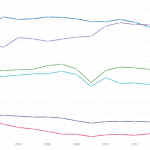The two-day Federal Reserve Open Market Committee (FOMC) meeting has started on Sep 25. Per the CME Group FedWatch Tool, the odds of a rate hike are 94%, which will be the eighth-rate hike since December 2015.
The popular Financial Select Sector SPDR Fund (XLF – Free Report) had inflows of $995 million over the past week (as of Sep 25), the highest since December and SPDR S&P Regional Banking ETF (KRE – Free Report) has attracted $309 million over the past five trading days (as of Sep 25) as investor are flocking toward financial ETFs having heavy exposure to banks to gain from rising interest rate scenario.
“Higher interest rates tend to boost banks’ profitability by expanding net interest margins, or the difference between what they make borrowing and what they make lending,” according to CNBC.
The hike in rates is a sign of an improving economy and banking sector is closely tied to how the nation’s economy functions. The yield on the benchmark 10-year Treasury note touched 3.113% (on Sep 25), just shy of its 2018 high of 3.128% that it hit in May. The yield on the 30-year Treasury bond hit 3.249%, its highest level since May 18.
A steeper yield curve leads to large interest margins for banks that like to borrow at short-term rates and lend for the long term. So, the present situation is a tailwind toward bigger bottom lines for the banking companies. Also, the large-cap banks have been investing in online platforms and mobile apps which will lure the young millennials and increase bottom lines as fewer costs will be incurred to maintain physical branches.
However, the short-term rates are rising in response to the rate hikes but long-term rates are not picking up due to growth and trade war concerns. As per a recent reading, the spread between the short and long terms has been 26 basis points and has been narrowing since late 2016. This could lead to an inverted yield curve-where the short-term rates surpass the long-term rates and result in a possible recession in the near future.








Leave A Comment